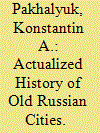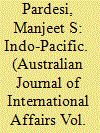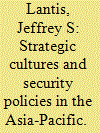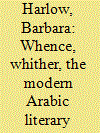|
|
|
Sort Order |
|
|
|
Items / Page
|
|
|
|
|
|
|
| Srl | Item |
| 1 |
ID:
189846


|
|
|
|
|
| Summary/Abstract |
In the regions of Central Russia, museum expositions actualize history
not only by putting it into the national context, but also by including
numerous references to the outside world. This is one of the mechanisms
by which representatives of local cultural elites, who are not directly related to the science and practice of international relations, provide guidelines
for the public understanding of world politics. Analysis based mainly on
field studies shows that the outside world simultaneously appears as both
something hostile and as a space of cooperation. “Russian antiquity” and
the Russian province are looking for conceptualization in international and
transnational perspectives, which are not always reduced to conflict.
|
|
|
|
|
|
|
|
|
|
|
|
|
|
|
|
| 2 |
ID:
176231


|
|
|
|
|
| Summary/Abstract |
The term ‘Indo-Pacific’ has now entered the strategic lexicon to refer to strategic Asia. In contrast to the dominant themes in the scholarly literature that emphasise its ‘newness’ and conceive it as a maritime space, I argue that Asia's three sub-regions (South, Southeast, and Northeast Asia) and two oceans (Indian and Western Pacific) have constituted a single strategic system for the past two centuries (with the notable exception of the last three decades of the Cold War). Importantly, future regional order in this ‘larger Asia’ will emerge from the interdependence of continental and maritime power. Approaching International Relations as an historical social science, I construct a new historical narrative to explain region (trans)formation. This larger strategic Asia that first emerged around the time of the ‘great divergence’ between the West and the rest was created by a rising Britain through its Indian base. While Cold War geopolitics ‘split’ Asia into smaller sub-regions, the rise of China and India is reversing this split. The contemporary re-emergence of the Indo-Pacific allows the United States to create a regional distribution of power and a regional distribution of status (through discourse) that favours the United States in an increasingly multipolar region.
|
|
|
|
|
|
|
|
|
|
|
|
|
|
|
|
| 3 |
ID:
132862


|
|
|
|
|
| Publication |
2014.
|
| Summary/Abstract |
Reflecting the culturalist turn in security studies, this special issue shows how one of the most powerful tools of security studies illuminates the origins and implications of the region's difficult issues, from the rise of China and the American pivot, to the shifting calculations of other regional actors. Strategic culture sometimes challenges and always enriches prevailing neorealist presumptions about the region. It provides a bridge between material and ideational explanations of state behaviour and helps to capture the tension between neoclassical realist and constructivist approaches. The case studies survey the role of strategic culture in the behaviours of Australia, China, Japan, the Philippines, South Korea, and the United States. They show the contrast between structural expectations and cultural predispositions as realist geopolitical security threats and opportunities interact with domestic elite and popular interpretation of historical narratives and distinctive political-military cultures to influence security policies. The concluding retrospective article devotes special attention to methodological issues at the heart of strategic cultural studies, as well as how culture may impact the potential for future conflict or cooperation in the region. The result is a body of work that helps deepen our understanding of strategic cultures in comparative perspective and enrich security studies. As disputes intensify over territory and resources, as regional militaries develop and leaders adjust their strategic calculus and defence commitments, the dovetailing of culture and politics in the Asia-Pacific shows through.
|
|
|
|
|
|
|
|
|
|
|
|
|
|
|
|
| 4 |
ID:
131552


|
|
|
|
|
| Publication |
2014.
|
| Summary/Abstract |
Postwar Lebanon, Sufism, imperial translations, Hamlet, trials and atlases, city streets, literary cafés, and Tahrir Square: disorienting as these various themes might appear to be, they nonetheless entitle eight recent inquiries into contemporary-and precedent-directions of literary critical studies of the modern Arabic novel and their calculated revisions of, perhaps, another Arabic literary historical narrative that necessarily engages multigenre, comparative literary-historical investigations. Each of the works under review here was published between 2010 and 2013, with just one specifically, and that ex post facto, addressing the momentous events in Cairo's Tahrir Square in the early months of 2011. In other words, these works might well have already anticipated a more than seasonal, some would even argue historic, "Arab spring," and at least several of the works' authors found it necessary to append an epilogue to their in-production text, or otherwise slightly, subtly, revise at the last minute their presumptive chronologies and the contested trajectories of modern Arabic literature that attend them. From the classically proverbial "tradition versus modernity" discussions through their historicist implications for the cultural production of new media and alternative public spheres, each of these studies seeks, in its own way/s, to instantiate Arabic literature-and Arabic literary criticism-within and against its respected precursors. But where will that self-same literature, and its current critical mediations, eventually wind up, whether globally, nationally, or historically?
|
|
|
|
|
|
|
|
|
|
|
|
|
|
|
|
|
|
|
|
|